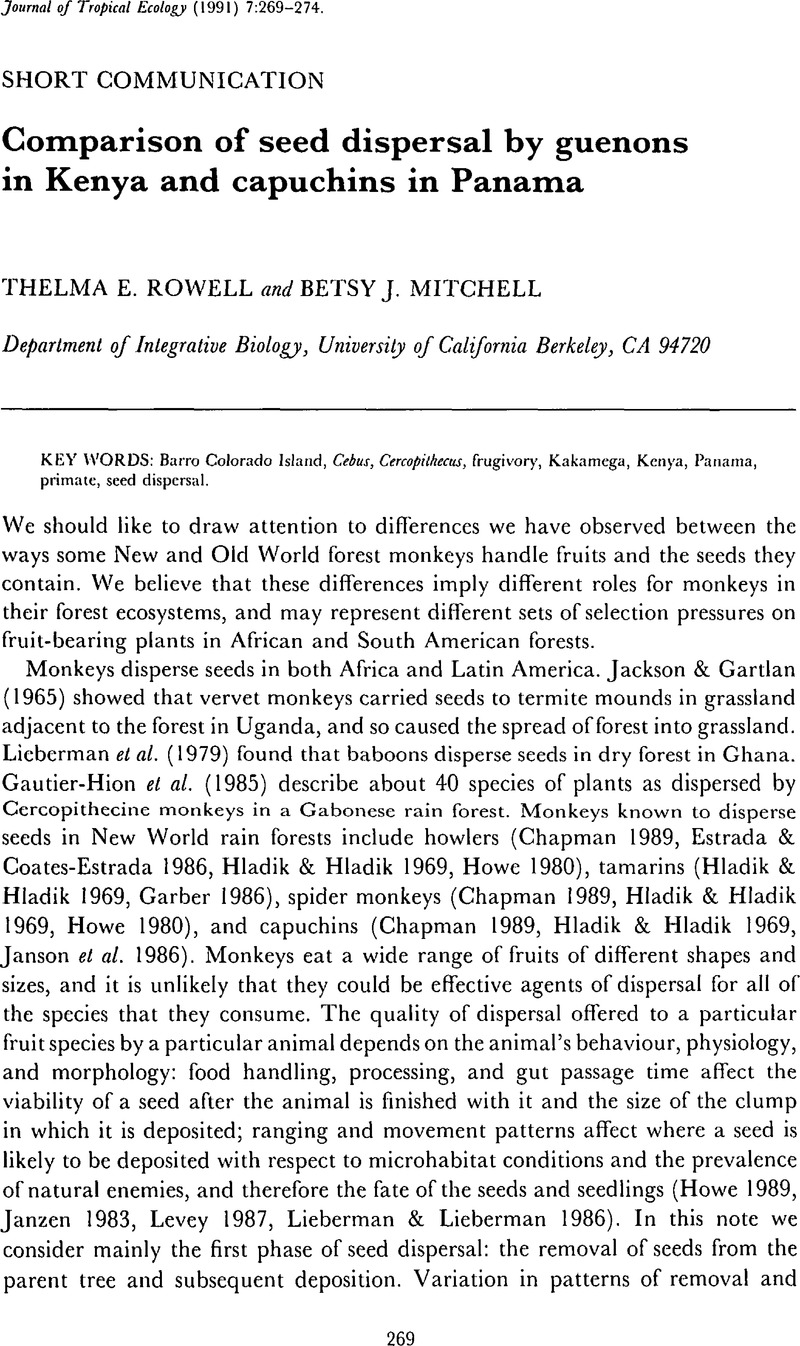Crossref Citations
This article has been cited by the following publications. This list is generated based on data provided by Crossref.
Galetti, Mauro
and
Pedroni, Fernando
1994.
Seasonal diet of capuchin monkeys (Cebus apella) in a semideciduous forest in south-east Brazil.
Journal of Tropical Ecology,
Vol. 10,
Issue. 1,
p.
27.
Guillotin, M.
Dubost, G.
and
Sabatier, D.
1994.
Food choice and food competition among the three major primate species of French Guiana.
Journal of Zoology,
Vol. 233,
Issue. 4,
p.
551.
Wrangham, Richard W.
Chapman, Colin A.
and
Chapman, Lauren J.
1994.
Seed dispersal by forest chimpanzees in Uganda.
Journal of Tropical Ecology,
Vol. 10,
Issue. 3,
p.
355.
Chapman, Colin A.
1995.
Primate seed dispersal: Coevolution and conservation implications.
Evolutionary Anthropology: Issues, News, and Reviews,
Vol. 4,
Issue. 3,
p.
74.
Izhaki, I.
Korine, C.
and
Arad, Z.
1995.
The effect of bat (Rousettus aegyptiacus) dispersal on seed germination in eastern Mediterranean habitats.
Oecologia,
Vol. 101,
Issue. 3,
p.
335.
Rogers, M. E.
Voysey, B. C.
McDonald, K. E.
Parnell, R. J.
and
Tutin, C. E. G.
1998.
Lowland gorillas and seed dispersal: The importance of nest sites.
American Journal of Primatology,
Vol. 45,
Issue. 1,
p.
45.
Chapman, Colin A.
and
Onderdonk, Daphne A.
1998.
Forests without primates: Primate/plant codependency.
American Journal of Primatology,
Vol. 45,
Issue. 1,
p.
127.
Kaplin, B. A.
Munyaligoga, V.
and
Moermond, T. C.
1998.
The Influence of Temporal Changes in Fruit Availability on Diet Composition and Seed Handling in Blue Monkeys (Cercopithecus mitis doggetti)1.
Biotropica,
Vol. 30,
Issue. 1,
p.
56.
Lambert, Joanna E.
and
Garber, Paul A.
1998.
Evolutionary and ecological implications of primate seed dispersal.
American Journal of Primatology,
Vol. 45,
Issue. 1,
p.
9.
Kaplin, Beth A.
and
Moermond, Timothy C.
1998.
Variation in seed handling by two species of forest monkeys in Rwanda.
American Journal of Primatology,
Vol. 45,
Issue. 1,
p.
83.
Lambert, Joanna E.
1999.
Seed handling in chimpanzees (Pan troglodytes) and redtail monkeys (Cercopithecus ascanius): Implications for understanding hominoid and cercopithecine fruit-processing strategies and seed dispersal.
American Journal of Physical Anthropology,
Vol. 109,
Issue. 3,
p.
365.
Otani, Tatsuya
and
Shibata, Ei’ichi
2000.
Seed dispersal and predation by Yakushima macaques, Macaca fuscata yakui, in a warm temperate forest of Yakushima Island, southern Japan.
Ecological Research,
Vol. 15,
Issue. 2,
p.
133.
Stevenson, Pablo R.
2000.
Seed dispersal by woolly monkeys (Lagothrix lagothricha) at Tinigua National Park, Colombia: Dispersal distance, germination rates, and dispersal quantity.
American Journal of Primatology,
Vol. 50,
Issue. 4,
p.
275.
McConkey, Kim R.
2000.
Primary seed shadow generated by gibbons in the rain forests of Barito Ulu, central Borneo.
American Journal of Primatology,
Vol. 52,
Issue. 1,
p.
13.
Clark, C. J.
Poulsen, J. R.
and
Parker, V. T.
2001.
The Role of Arboreal Seed Dispersal Groups on the Seed Rain of a Lowland Tropical Forest1.
Biotropica,
Vol. 33,
Issue. 4,
p.
606.
Clark, C. J.
Poulsen, J. R.
and
Parker, V. T.
2001.
The Role of Arboreal Seed Dispersal Groups on the Seed Rain of a Lowland Tropical Forest1.
BIOTROPICA,
Vol. 33,
Issue. 4,
p.
606.
Poulsen, John R.
Clark, Connie J.
Connor, Edward F.
and
Smith, Thomas B.
2002.
DIFFERENTIAL RESOURCE USE BY PRIMATES AND HORNBILLS: IMPLICATIONS FOR SEED DISPERSAL.
Ecology,
Vol. 83,
Issue. 1,
p.
228.
Meehan, Hayley J.
McConkey, Kim R.
and
Drake, Donald R.
2002.
Potential disruptions to seed dispersal mutualisms in Tonga, Western Polynesia.
Journal of Biogeography,
Vol. 29,
Issue. 5-6,
p.
695.
Righini, Nicoletta
Serio‐Silva, Juan Carlos
Rico‐Gray, Victor
and
Martínez‐Mota, Rodolfo
2004.
Effect of different primate species on germination of Ficus (Urostigma) seeds.
Zoo Biology,
Vol. 23,
Issue. 3,
p.
273.
Wehncke, Elisabet V.
and
Dalling, James W.
2005.
Post‐Dispersal Seed Removal and Germination Selected Tree Species Dispersed byCebus capucinuson Barro Colorado Island, Panama1.
Biotropica,
Vol. 37,
Issue. 1,
p.
73.





